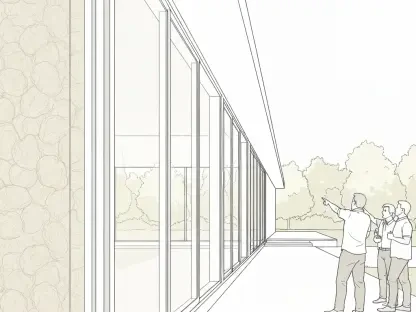In today’s rapidly evolving business landscape, integrating smart technology into office design is not just a trend—it’s becoming an essential element for creating functional and aesthetically pleasing workspaces. Smart technology, with its promise of enhancing both comfort and efficiency, is reshaping how offices are conceptualized and executed. Leveraging advanced systems like ABB’s i-bus® KNX, office environments are being transformed into dynamic spaces that function as active participants in the daily operations of enterprises. The case study of the Archice architectural firm’s office in Hanza Tower, Szczecin, Poland serves as a prime example of this transformation. This office seamlessly embodies a modern solution that merges automation, energy efficiency, and sophisticated design, setting a new benchmark for future-ready office environments.
Merging Aesthetics with Functionality
The Archice office project highlights the power of integrating aesthetics with cutting-edge functionality. The firm’s approach focused on creating an environment where design and smart technology coexist harmoniously, making the workplace both a hub of productivity and a space that excites the senses. Central to this strategy was the installation of automated systems for curtains, ventilation, and metering, each of which contributes to real-time management of lighting and temperature based on room conditions. These systems address the perennial issues faced by modern offices, such as the heat challenges due to extensive glass windows and the power demands of high-performance computers.
By implementing automated solutions, the Archice office exemplifies how technology can maintain ideal environmental conditions without requiring constant manual adjustments. This automation plays a crucial role in curbing energy expenditures and improving the overall comfort level for employees. The adoption of such technology underscores the growing importance of office spaces that are as functional as they are beautiful, turning workspaces into live showrooms where potential clients can witness firsthand the benefits of smart design.
Practical Benefits and Integration
Smart office design doesn’t just focus on aesthetics; it brings practical benefits that go beyond reducing energy costs. The collaboration with systems integrator FUTYMA Systemy Inteligentne was pivotal in the successful implementation of the KNX and DALI control systems in the Archice office. These systems leverage sensors to detect motion and temperature changes, enabling dynamic adjustments that cultivate an optimal work environment. The presence of such sophisticated systems illustrates how technology can enhance security, efficiency, and the overall appeal of an office space.
The visual centerpiece of the Archice office is the ComfortLine cabinet, showcasing the perfect synergy between digital and architectural design. This element beautifully illustrates the integration of technology with design, serving as both a functional and decorative focal point. As the demand for smart office spaces grows, this kind of integration not only improves operational efficiency but also invites a modern ambiance that appeals to both staff and visitors. These installations represent how offices worldwide are navigating the complexities of modern business needs against the backdrop of rising energy concerns and the necessity for sustainable practices.
Trends and Collaborative Efforts
The trend toward increased automation in commercial spaces is driven by a growing awareness of its benefits and the financial incentives of energy savings. As demonstrated by the Archice project, smart technology’s role in office design is broadening, covering everything from cost-efficiency to acting as a deterrent against security breaches. This shift reflects a significant change in how businesses view their operational spaces—not just as locations to conduct work, but as strategic assets in achieving broader organizational goals.
Key to the successful deployment of these systems is the collaboration between various stakeholders, from system integrators to equipment manufacturers. Their joint efforts ensure that installations are not only tailored to current demands but also adaptable to future technological advancements. The synergy achieved through such collaborations highlights the critical role that strategic partnerships play in the successful adoption of smart technology in office design. The success story of the Archice office installation serves as a model for future projects, demonstrating the transformative potential of integrating cutting-edge technology into traditional architectural paradigms.
Future Considerations
The Archice office project demonstrates the potential of blending aesthetics with advanced functionality. Their approach aimed to create a workspace where design and smart technology coexist, turning the office into a productivity hub that also pleases the senses. A key part of this was installing automated systems for curtains, ventilation, and metering, which adjust lighting and temperature in real-time based on room conditions. These systems tackle common problems in modern offices like the heat from large glass windows and the high power usage of powerful computers.
By adopting these automated solutions, Archice shows how technology can optimize environmental conditions without needing constant manual intervention. This automation is vital for reducing energy costs and enhancing employee comfort. The use of such technology highlights the increasing necessity for office spaces to be as practical as they are visually appealing, transforming work areas into live showrooms. Here, potential clients can see firsthand the advantages of integrating smart design, witnessing how function and form come together seamlessly.









